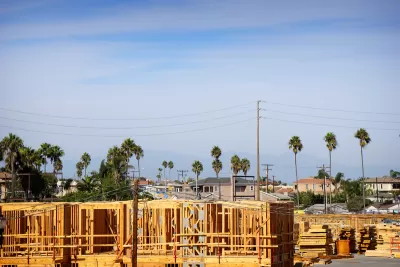A new study highlights how many — or how few — Californians can afford to live in each of the state’s counties.

A new study from the University of California, Berkeley’s Terner Center for Housing Innovation attempts to change the conversation about housing affordability.
As Erin Baldassari explains in an article for KQED, the study “argues the classic question — ‘Is a place affordable?’ — should instead be supplanted with a new one: ‘Who can afford this place?’” The subtle difference between those two questions can illuminate stark disparities. For example, “we’ve been saying Beverly Hills is perfectly affordable because the people who live there can afford it.”
To shift to a new definition of affordability, researchers used data about housing costs, income, and other expenses to assess affordability by county for all Californians. “The result is an interactive map that shows how many Californians could afford to live in each county — which paints a much bleaker picture of the state’s most expensive areas than had previously been shown.” The study also accounts for things like access to transportation, which can lower the cost of living in urban areas, somewhat balancing out more expensive rents.
The study’s findings could lead to changes in how policymakers define affordability to better account for overall costs — but changes to housing assistance programs would likely require major injections of new funding.
FULL STORY: California Housing Is Even Less Affordable Than You Think, UC Berkeley Study Says

Maui's Vacation Rental Debate Turns Ugly
Verbal attacks, misinformation campaigns and fistfights plague a high-stakes debate to convert thousands of vacation rentals into long-term housing.

Planetizen Federal Action Tracker
A weekly monitor of how Trump’s orders and actions are impacting planners and planning in America.

In Urban Planning, AI Prompting Could be the New Design Thinking
Creativity has long been key to great urban design. What if we see AI as our new creative partner?

King County Supportive Housing Program Offers Hope for Unhoused Residents
The county is taking a ‘Housing First’ approach that prioritizes getting people into housing, then offering wraparound supportive services.

Researchers Use AI to Get Clearer Picture of US Housing
Analysts are using artificial intelligence to supercharge their research by allowing them to comb through data faster. Though these AI tools can be error prone, they save time and housing researchers are optimistic about the future.

Making Shared Micromobility More Inclusive
Cities and shared mobility system operators can do more to include people with disabilities in planning and operations, per a new report.
Urban Design for Planners 1: Software Tools
This six-course series explores essential urban design concepts using open source software and equips planners with the tools they need to participate fully in the urban design process.
Planning for Universal Design
Learn the tools for implementing Universal Design in planning regulations.
planning NEXT
Appalachian Highlands Housing Partners
Mpact (founded as Rail~Volution)
City of Camden Redevelopment Agency
City of Astoria
City of Portland
City of Laramie





























